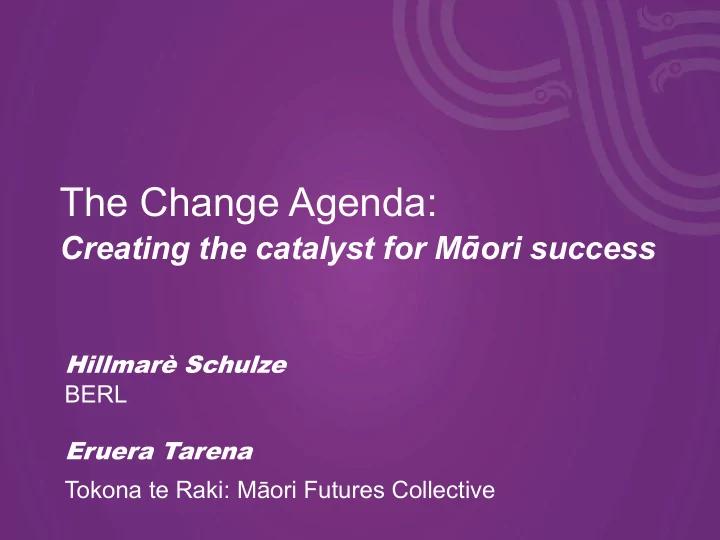

The Change Agenda: Creating the catalyst for M ā ori success Hillmarè Schulze BERL Eruera Tarena Tokona te Raki: M ā ori Futures Collective
Equity means fairness ….and one of the fundamental principles of fairness is that every one should have the opportunity to succeed
Current income gap for Income gap Māori is $2.6 billion per year 60,000 Average income 50,000 40,000 30,000 20,000 20-24 25-29 30-34 35-39 40-44 45-49 50-54 55-59 60-64 Age New Zealand Maori
What would happen if we ignore this income gap? 2013 2038 75+ 75+ 70-74 70-74 65-69 65-69 60-64 60-64 55-59 55-59 50-54 50-54 45-49 45-49 40-44 Age 40-44 Age 35-39 35-39 30-34 30-34 25-29 25-29 20-24 20-24 15-19 15-19 10-14 10-14 5-9 5-9 0-4 0-4 15% 10% 5% 0% 5% 10% 15% 15% 10% 5% 0% 5% 10% 15% % of population % of populaiton Māori New Zealand Māori New Zealand By 2038, if this level of inequality persists, the income gap will increase to $4.3 b bil illi lion per er y yea ear
Why does this gap exist? Average hours worked per week 50% Work t the s he same e 40% % of population hours 30% 20% 10% 0% 1-9 10-19 20-29 30-39 40-49 50-59 60+ Hours worked New Zealand Māori Skill level of occupation 40% 30% % of population 20% 10% 0% 1 2 3 4 5 Occupation skill level (1=Highest) New Zealand Māori
Even more pronounced in education No qualification 60% By 2038, 2038, t there w will b be: • % of population 95,000 Māori requiring qualifications and 40% 80,000 requiring at least level five qualifications 20% to match the national average education levels. 0% 15-19 20-24 25-29 30-34 35-39 40-44 45-49 50-54 55-59 60-64 65-69 70-74 75+ Age New Zealand Māori Level 5 or above 50% % of populaiton 40% 30% 20% 10% 20-24 25-29 30-34 35-39 40-44 45-49 50-54 55-59 60-64 65-69 70-74 75+ Age New Zealand Māori
43 % of the Māori Future jobs wo workforce a e are employed in these two sectors 1 % of the Māori wo workforce a e are employed
So what??? 1. What stands out for you? 2. What do you disagree with? 3. What is the issue to be addressed? 4. What urgency is felt about this issue? 5. What do we know about the causes? What more do we need to know?
Next steps 1. M ā ori receive low incomes 2. M ā ori are in low skill jobs 3. M ā ori are less educated 4. M ā ori are very young We need to create a pipeline of opportunity, starting with tamariki for lasting M ā ori success
Transition Transition Transition 1 2 3 School High School Post School Employment State State University Employment Private Private Trade ITO Industry Income Kura Kaupapa Māori Medium Polytech Māori Medium Work None None NEET NEET
Moving beyond good intentions Problem is clearly defined Problem is hard to define with many parts Solutions is a predictable Solution requires changes to process beliefs & ways of working Focus on short - term outputs Focus on long -term outcomes Project delivery Changing conditions & systems Address symptoms Tackle root causes
OUR APPROACH Create transformational education and training pathways to provide whānau with the education they deserve and connect them to the jobs of the future Work across education, employers, agencies and whānau to build an integrated careers system to boost Māori outcomes Move beyond BAU by supporting partners to create new solutions, innovate, learn and adapt
How it would work
Launching the waka Join our collective and champion the cause Identify your champions & know what you bring to the table Change isn’t ‘out there’ but ‘in here’
Now what??? 1. What would inspire you to contribute? 2. What would you need to participate? 3. What can you contribute? 4. Who else needs to be involved for progress to occur? 5. What could we achieve together?
Now what: Systems Change • Scale wide, scale deep, scale up
Recommend
More recommend